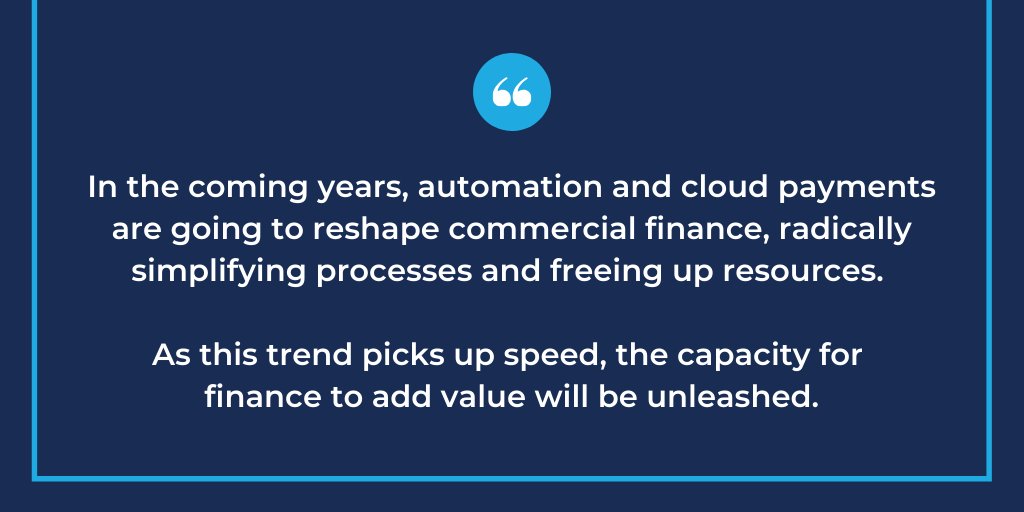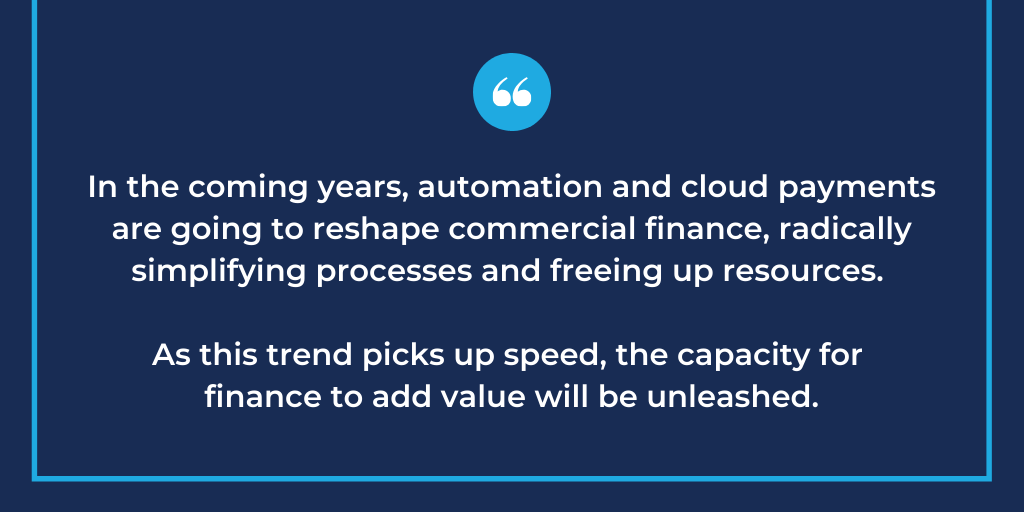AFP 2019: Takeaways for B2B Payments & Commercial Finance


Real-time payments, machine learning, decentralized ledgers – how do you sort through the hype and figure out what’s important in 2020? That's what this year's AFP Treasury and Finance Conference was all about. The event, which attracted more than 7,000 attendees, highlighted how technology is expected to continue disrupting accounting and finance. Read on for an insider’s recap of the event's top takeaways.
The fact that this year focused so heavily on tech is one of the most concrete signs of just how far and how quickly our industry is changing. A few years ago, artificial intelligence and blockchain hardly came up at AFP (if at all). But this year, speakers and exhibitors scrambled to outbid one another in announcing bold predictions for how emerging technology will reshape the B2B Payments landscape.
While addressing a lot of different topics, this year's sessions all paint a picture of a digital future speeding up in all directions. Here are three takeaways from the Paystand team on the ground
1. "Digital Transformation in Payments is an Endless Journey with Shifting Destinations."
How, in such a rapidly shifting world, can treasury and finance professionals educate themselves to prepare for the future? This was by far the most common theme we overheard at the event, with many attendees noting how quickly the payment landscape has changed in recent years, while others felt the digital transformation journey had no end in sight. Kevin Ang, who oversees treasury advisory for Citi's Americas region, flipped the conversation by suggesting digital transformation is actually "constantly evolving" with a destination that keeps shifting.
In his role, Kelvin Ang is charged with advising clients on treasury operations and treasury technology. This role gives him a unique perspective on the challenges of digital transformation. During his session, he continued the conference's theme of determining which technologies to pay attention to (‘reality’) and which to avoid (‘hype’), and offered the following sage advice:
- Digitization is a journey of changing the way we work globally. In order to succeed, we need to get better at noting the difference between investing in technology to capture the benefit of a trend (reality) and pursuing a change simply to keep up with an industry pattern (hype). The only way to really know something is to go deep. And the only way you can go deep is to acquire knowledge in a fairly old fashioned way. You have to read stuff, you have to pay attention, and you have to focus.
- Successful transformation is a team support. When people are more involved in change efforts, a transformation’s success is more likely. You need to really make digital part of everyone’s job. Have them work together to learn as they go. Immersion is especially important for senior leadership, and managers need to be hands-on and understand how people in their organization use technology.
There's a lot to unpack in these two points, so below I'll touch base on a few actionable tips you can use to put this advice into action:
- Start with a clear goal in mind. Do you want to simplify processes, automate tasks, gain insight, etc.? The answer will determine your next steps.
- Build a team of omnivores. Look for people from varied backgrounds, that are comfortable trying new tools and approaches, and bias toward smart action steps rather than becoming mired in analysis.
- Make cross-collaboration a norm. When people work together, they better understand each other's challenges and capabilities, which improves collaboration. Shared cross-functional goals and matrix reporting can help drive this.
- Encourage experiments. You might not find the digital tools that work for your team on the first try, and that's okay. Identify small projects for quick experiments and shorter feedback cycles.
2. Eliminating Payment Fees Isn't Radical — It's Actually Realistic.
Right now, we generally only hear about reducing and eliminating payment fees from more radical startups, but Kristopher Riley, head of business development at Paystand, says this dynamic is quickly changing and many companies are now realizing the benefits of ditching legacy payment methods.
"Organizations are demanding lower costs, so they're dipping their toes into digital payments, which include more data, control, and automation," Kristopher said, noting that while this does reduce costs and risks in general, the greatest benefits lie in eliminating inefficiencies and fraud. "While traditional payment rails are still reliable, the shift to digital options is really about fixing broken processes and reducing operational risk. That's why eliminating fees is no longer seen as such a radical idea."
Sticking to the legacy payment methods of the past will only serve to drive new potential customers away, and cost a lot of money while you’re doing it. Here are some tips from the event:
- For large merchants (annual card sales of $100M+), Interchange fees represent about 85% of the total cost of card fees. These fees can be managed and in most instances negotiated with the card network. This is something Paystand does on behalf of all its customers.
- Merchants have multiple ways to lower fees and costs, such as by eliminating downgrades or using features like Least Cost Routing or Payer-Pays-Fees. You can negotiate quarterly rebates, but this usually only works if you're a larger merchant.
- Assessment and dues are the second largest cost of card processing, which make up 10% of your total costs and represent revenue you are handing directly to card associations. While all card processors are subject to these fees, be aware that many markup these fees to merchants.
- If your payment costs cannot be tracked and analyzed, they cannot be improved or optimized. Using complex, analog processes makes it more difficult for your organization to manage risks and costs.
3. Real-time is Becoming an Industry Standard, But Processes Still Need to Catch Up.
Without a doubt, real-time payments was top of mind for everyone in attendance. However, some still felt skeptical about the implementation and execution. Overheard on the shuttle to the event, "I'm really interested in real-time payments, but I don't know if it's going to happen. Getting a real-time balance is almost impossible, never mind a real-time payment." This was from a banking treasurer relating her challenges about "giving customers what they want, when they want it and where they want it."
As someone in the payment space, I hear that and can't help but notice how quickly the demand for real-time payments is growing. More companies appear to be investing in real-time technology than any other area, with 33% of companies saying they plan to roll out real-time payment innovations in the next three years. Now consider that more than 600 retail banks have already signed up to pursue real-time payments through Zelle, and wholesale banks are now testing new services that could shift volumes from ACH and Wire while protecting margins.
During the "Realizing the Benefits for Faster Payments for the Corporate Treasurer" session at the conference, panelists offered several takeaways for attendees hot to try real-time payments:
- Real-time payments are not straightforward to implement, but it’s one of those things that banks will need to do to grow their businesses. Banks must help build the systems, align on the language across payment schemes and borders, and drive consistency and regulations in each jurisdiction.
- In order to adopt faster payment solutions, it’s helpful to first look for use cases and sequence your resources rather than try to force faster payments to solve for everything at once.
- Various faster payments solutions exist in the U.S. market today and offer clear benefits to businesses, such as greater transparency in identifying where the money is, easier reconciliation processes, lower costs, and faster access to capital.
Next Steps!
We spent last week navigating through the maze of sessions, keynotes, and bold talks at MindShift Row, trying to soak up every bit of knowledge we could. These are just three of the takeaways from our jam-packed days of AFP ideas from some of the most forward-thinking minds on the planet.
We were lucky enough to get this inspiration first-hand, and now we can share with you. To get started implementing some of these learnings, download our free eBook The Controller's Guide to B2B Payment Optimization. If you found this advice helpful, you’ll be in for a great read that provides real value for what’s next in your profession.






